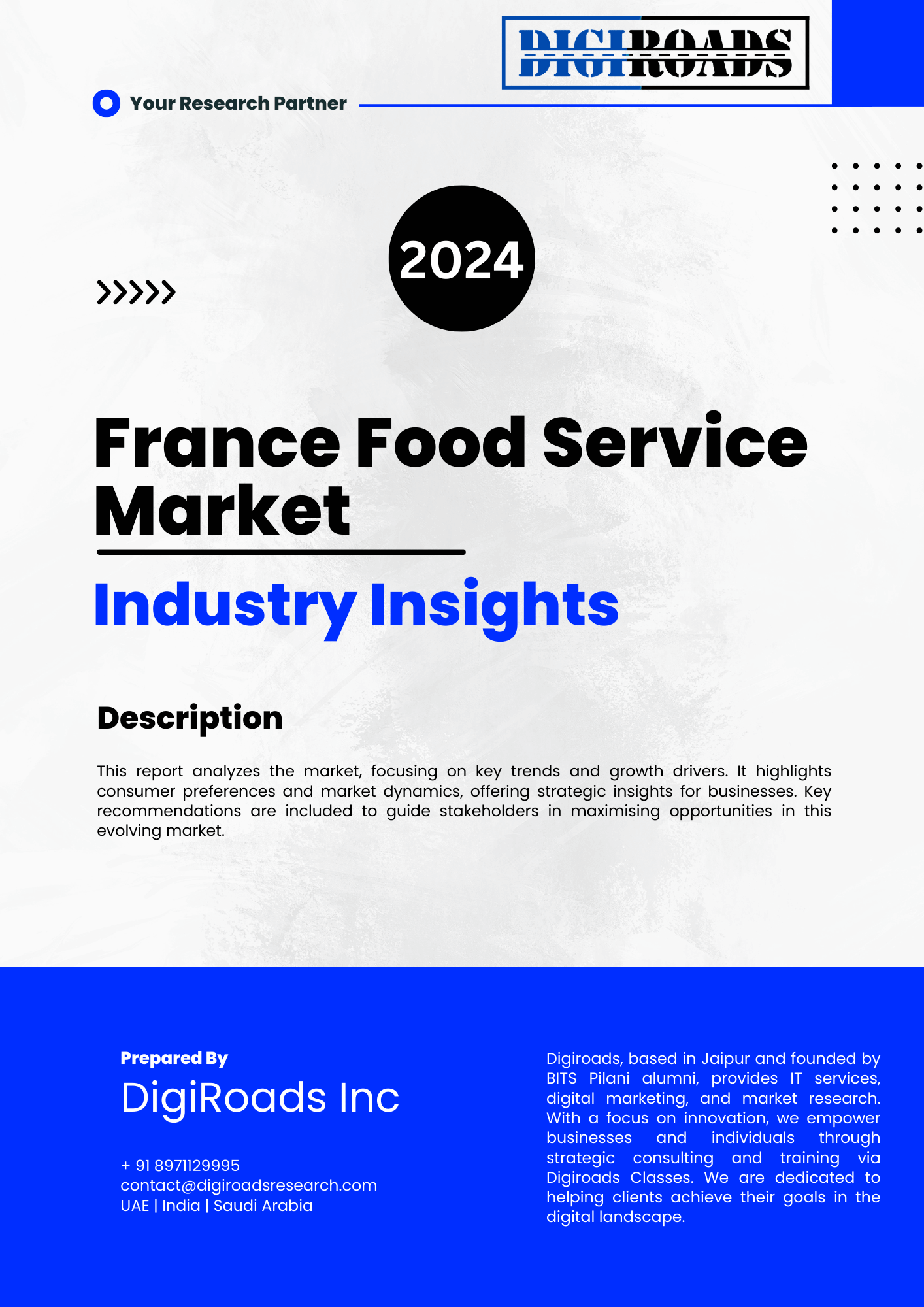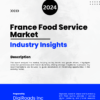France Food Service Market
- Brand: DigiRoads
The comprehensive 120-page France Food Service Market report delves into market trends, consumer behavior, and key players. It explores the growing demand for gourmet, organic, and international cuisines, alongside insights on distribution channels and regional preferences.
France Food Service Market: Opportunity Analysis and Industry Forecast, 2024-2034
France Food Service Market Overview:
The France Food Service Market size is estimated at 78.58 billion USD in 2024, and is expected to reach $138.58 billion USD by 2034,growing at a CAGR of 6.50% during the forecast period (2024-2034).
The France Food Service Market is a dynamic and diverse industry that caters to the culinary preferences of a discerning and gastronomically inclined population. Renowned for its rich culinary heritage, France boasts a thriving food service sector characterized by a wide array of dining establishments, from traditional bistros to Michelin-starred restaurants.
With a strong emphasis on quality, authenticity, and innovation, the French food service market is a hub of culinary creativity and gastronomic excellence. Traditional French cuisine, characterized by exquisite flavors and meticulous preparation, coexists harmoniously with contemporary and international culinary trends. From iconic patisseries offering delectable pastries to bustling cafes and fine dining establishments, the market caters to diverse consumer tastes and preferences.
The dining culture in France extends beyond the traditional restaurant setting, encompassing vibrant street food markets, quaint brasseries, and trendy food trucks. Embracing both tradition and innovation, the France Food Service Market continues to evolve, driven by a passion for culinary excellence and a commitment to providing unforgettable dining experiences.
France Food Service Market – Report Coverage:
The “France Food Service Market Report – Forecast (2024-2034)” by Digiroads Consulting, covers an in-depth analysis of the following segments in the France Food Service Market.
| Attribute | Segment |
| By Food service Type |
|
| By Cuisine Type |
|
| By Service Model |
|
| By End User |
|
| By Price Range |
|
| By Technology Integration |
|
| By Location |
|
Recent Developments :
Technological Advancements:
QR Code Menus and Online Ordering: Replacing traditional menus with scannable QR codes allows for contactless ordering and menu updates in real-time, improving both customer experience and operational efficiency.
Robotic Servers and Kitchen Assistants: Restaurants are experimenting with robots for tasks like serving food, clearing tables, and preparing basic dishes, addressing labor shortages and enhancing efficiency.
Delivery Automation and Drones: Some companies are exploring self-driving delivery vehicles and drone delivery for shorter distances, aiming to streamline and expedite food delivery in urban areas.
Sustainability Initiatives:
Focus on Locally Sourced Ingredients: Local sourcing initiatives are gaining traction, reducing carbon footprint and supporting regional farmers while contributing to fresher and more authentic flavors.
Compostable Packaging and Waste Reduction: Restaurants are adopting eco-friendly packaging solutions and implementing food waste reduction strategies to minimize environmental impact and align with growing consumer demand for sustainability.
Energy Efficiency and Carbon Reduction: Investing in energy-efficient equipment and adopting renewable energy sources are becoming priorities for environmentally conscious restaurants.
Emerging Culinary Trends:
Plant-Based and Vegan Options: The demand for plant-based and vegan alternatives is rapidly growing, leading to an increase in vegetarian and vegan restaurants, along with expanded meat-free options on traditional menus.
Ethnic and Fusion Cuisine: The French are embracing diverse culinary influences, with restaurants offering exciting fusion dishes combining French classics with Asian, Latin American, and Middle Eastern flavors.
Healthy and Functional Food: Health-conscious consumers are driving the demand for nutritious and functional food options, emphasizing fresh ingredients, superfoods, and dishes tailored to specific dietary needs.
Other noteworthy developments:
The rise of cloud kitchens and ghost restaurants: Targeting delivery-focused operations, these kitchens offer lower overhead costs and cater to the growing demand for convenient food delivery.
Increased focus on personalization and customization: Restaurants are allowing customers to personalize their meals through customizable menus and interactive dining experiences.
Government initiatives to support the industry: Tax breaks and financial aid programs are being implemented to help restaurants recover from the pandemic’s impact and encourage innovation.
France Food Service Market – Dynamics:
Drivers:
Strong tourism industry: France, a global tourist destination, attracts millions of visitors seeking the quintessential French dining experience, boosting demand for diverse food service options.
Rising disposable incomes and urbanization: An affluent population, particularly in urban areas, has increasing spending power and seeks convenient and diverse dining experiences.
Shifting demographics and changing lifestyles: Busy work schedules and growing awareness of health contribute to demand for quick service restaurants (QSRs) and healthy food options.
Evolving consumer preferences: French consumers are increasingly open to culinary exploration, embracing international cuisines and innovative food concepts.
Focus on local sourcing and sustainability: Growing interest in supporting local farmers and reducing environmental impact fuels demand for restaurants using regional ingredients and sustainable practices.
Opportunities:
Expanding delivery and takeaway services: Leveraging online platforms and efficient delivery systems can cater to busy lifestyles and reach a wider customer base.
Catering to diverse dietary needs: Offering vegan, vegetarian, gluten-free, and allergy-friendly options can attract a broader clientele and address growing health concerns.
Investing in cloud kitchens and virtual restaurants: This cost-effective model allows operators to experiment with new concepts and reach customers without the burden of traditional restaurant setups.
Enhancing digital experiences: Implementing online ordering, customer loyalty programs, and personalized recommendations can attract tech-savvy consumers.
Embracing local food movements and sustainable practices: Highlighting partnerships with local farms, using eco-friendly packaging, and reducing food waste can resonate with environmentally conscious consumers.
Restraints:
High labor costs and stringent regulations: Strict labor laws and complex regulations can increase operational costs and limit flexibility for businesses.
Intense competition and market saturation: A crowded market with numerous establishments requires strong differentiation strategies to stand out.
Economic uncertainties and fluctuating inflation: Economic slowdowns and inflation can impact consumer spending and affect market stability.
Dependence on tourism: Tourist fluctuations can impact certain segments of the market, particularly those catering to international visitors.
Maintaining traditional image and balancing innovation: French consumers place high value on traditional cuisine and culinary heritage, requiring careful adaptation of new trends.
Challenges:
Attracting and retaining skilled workforce: High staff turnover and limited availability of trained personnel can affect service quality and operational efficiency.
Adapting to changing digital landscapes and consumer expectations: Keeping up with evolving online ordering systems, delivery apps, and consumer preferences requires constant innovation and investment.
Balancing affordability with quality and sustainability: Meeting expectations for fresh, local ingredients and sustainable practices while maintaining price competitiveness can be challenging.
Managing food waste and reducing environmental impact: Implementing efficient waste reduction strategies and adopting sustainable practices are crucial for cost-effectiveness and environmental responsibility.
Addressing concerns about portion sizes and unhealthy options: Balancing French culinary traditions with healthier meal options without compromising portion sizes can be a balancing act.
Key Market Players:
Product/Service launches, approvals, patents and events, acquisitions, partnerships and collaborations are key strategies adopted by players in the France Food Service Market . The top 10 companies in this industry are listed below:
- McDonald’s Corporation
- Groupe Bertrand (Operator of brands like Burger King, Au Bureau, etc.)
- Sodexo
- Elior Group
- Compass Group
- Accor SA (Includes brands like Ibis, Novotel, etc.)
- Domino’s Pizza Group plc
- Buffalo Grill
- Quick (Groupe Financière Quick)
- Le Duff Group (Operator of brands like Brioche Dorée, Del Arte, etc.)
Key Benefits For Stakeholders:
Strategic Insights: Gain valuable market intelligence for informed decision-making.
Market Expansion: Identify growth opportunities and potential market entry points in the dynamic French food service industry.
Competitive Edge: Stay ahead with comprehensive insights into key players, market trends, and emerging consumer preferences.
Regulatory Compliance: Navigate the market landscape with an understanding of regulatory frameworks and compliance requirements in the French market.
Consumer Trends: Stay abreast of evolving consumer behaviors and preferences to tailor offerings and enhance customer satisfaction.
Investment Opportunities: Identify potential areas for investment and collaboration within the vibrant food service sector in France.
Operational Efficiency: Streamline operations with insights into industry best practices, supply chain optimization, and technological advancements.
Partnerships and Alliances: Identify strategic partnerships and alliances to foster business growth and market presence.
Risk Mitigation: Assess and mitigate risks by staying informed about market dynamics, economic trends, and external factors affecting the food service industry.
Informed Decision-Making: Equip stakeholders with the knowledge needed to make well-informed decisions, ensuring long-term success in the dynamic French food service market.
We have studied the France Food Service Market in 360 degrees via. both primary & secondary research methodologies. This helped us in building an understanding of the current market dynamics, supply-demand gap, pricing trends, product preferences, consumer patterns & so on. The findings were further validated through primary research with industry experts & opinion leaders across countries. The data is further compiled & validated through various market estimation & data validation methodologies. Further, we also have our in-house data forecasting model to predict market growth up to 2034.
Contact us for any inquiry.
Table of Contents
- INTRODUCTION
1.1 Study Assumptions & Market Definition
1.2 Scope of the Study
- RESEARCH METHODOLOGY
- EXECUTIVE SUMMARY
- MARKET DYNAMICS
4.1 Market Overview
4.2 Market Drivers
4.3 Market Restraints
4.4 Porter’s Five Forces Analysis
4.4.1 Bargaining Power of Suppliers
4.4.2 Bargaining Power of Buyers
4.4.3 Threat of New Entrants
4.4.4 Threat of Substitute Products
4.4.5 Intensity of Competitive Rivalry
- MARKET SEGMENTATION
- France Food Service Market – By Food service Type
- Restaurants
- Cafes
- Fast Food Chains
- Fine Dining
- Food Trucks
- Catering Services
- Others
- France Food Service Market – By Cuisine Type
- French Cuisine
- Mediterranean Cuisine
- International Cuisine
- Fusion Cuisine
- Others
- France Food Service Market – By Service Model
- Quick Service Restaurants (QSR)
- Full-Service Restaurants (FSR)
- Casual Dining
- Fine Dining
- Cafes and Coffee Shops
- Buffet Style
- Food Delivery/Takeaway
- By End User:
- Individual Consumers
- Tourists
- Corporate Clients
- Events and Occasions
- By Price Range:
- Budget-Friendly
- Mid-Range
- Premium
- By Technology Integration:
- Online Ordering
- Mobile Apps
- Digital Menus
- Contactless Payments
- COMPETITIVE LANDSCAPE
6.1 Most Adopted Strategies
6.2 Market Share Analysis
6.3 Company Profiles
- McDonald’s Corporation
- Groupe Bertrand (Operator of brands like Burger King, Au Bureau, etc.)
- Sodexo
- Elior Group
- Compass Group
- Accor SA (Includes brands like Ibis, Novotel, etc.)
- Domino’s Pizza Group plc
- Buffalo Grill
- Quick (Groupe Financière Quick)
- Le Duff Group (Operator of brands like Brioche Dorée, Del Arte, etc.)
- MARKET OPPORTUNITIES AND FUTURE TRENDS


